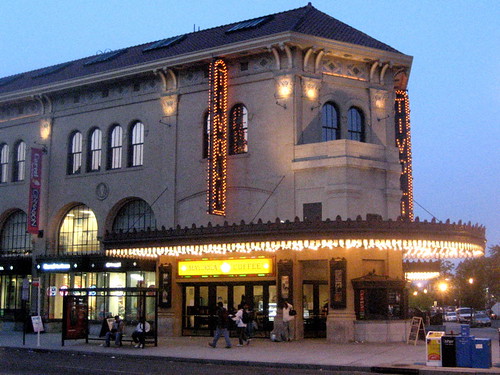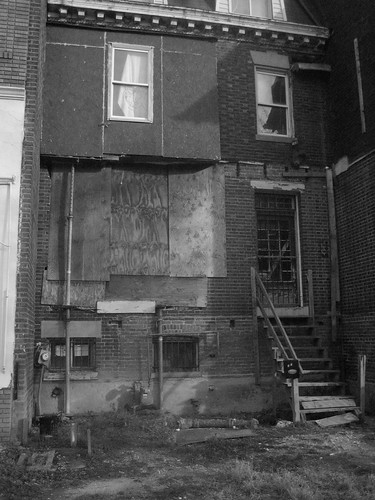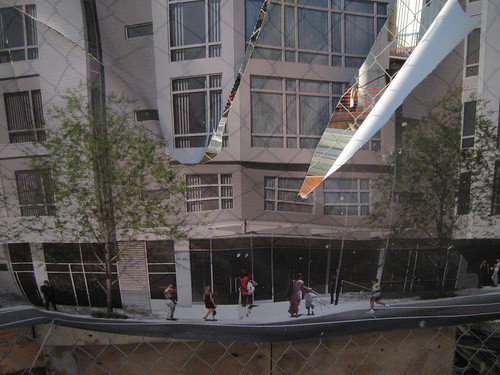
WASHINGTON, DC — I flew down to the Washington, DC area earlier this week to celebrate Christmas with my Jewish family. Staying in the suburb of Kensington, Maryland, at a home that boasts a walking score of 26, I journeyed inside the Beltway to the heart of the District to get the conventional and unconventional tourist experience.
South of K Street, known for its legions of lobbyists, think tanks and industry associations, is the National Mall — the destination of patriotic pilgrims from Maine to California and all points in between. It includes the Capitol building, the White House, the Washington Monument, the Supreme Court, various federal bureaucracies, and the national museums and galleries. It embodies the “well manicured†city that Liz Clayton referenced in her November post on DC.
Everything in Washington is meant to kneel down before the neoclassical Capitol. In fact, until 1910, it was written in law that no building in Capital City could eclipse the height of the Capitol building. Now height restrictions limit new buildings to no more than 20 feet taller than the width of the road in front of it, which I imagine is almost always shorter than the 288 foot tall Capitol.

Walking Washington’s 14th Street north of K Street, however, is like being in an entirely different city than the White House. I started a couple miles north of K in the Columbia Heights neighbourhood, in front of a dilapidated and boarded up pre-World War II row house (pictured). The home that appeared to have sat empty for decades featured the characteristic burn marks that are common among older buildings in this predominantly African-American neighbourhood that, historically, was home to many of Washington’s top civil servants.
Fourteenth Street was the centre of the 1968 race riots that broke out in Washington, and across the United States, in the wake of the assassination of Martin Luther King, Jr. Until the late 1990s, 14th sat virtually untouched after the riots cemented the area as a black ghetto in the eyes of the city’s elite, leaving charred remains for close to two generations. According to locals, up until the earlier part of this decade, 14th was synonymous with poverty, drugs and sex trade workers. The regeneration (and gentrification) of the neighbourhood is now in mid-swing and it seems to be attributable to two major changes.
Foremost, the Development Corporation of Columbia Heights, dedicated to community and economic development since 1984, finally began to get traction at City Hall in the 90s. Along with more elite groups like the Committee of 100 (similar to the Toronto City Summit Alliance), the community-based group was able to make the case for investment from local government and influence the changes to be made. The landmark development in the plan was the historic Tivoli Theatre (the first picture in this post).
An architectural treasure since it opened in 1924, the Tivoli, like most businesses in the area, went under in the 1970s. In 2005, the curtain at the Tivoli lifted once again, an accomplishment many in DC thought would never happen.
In the Tivoli redevelopment, Columbia Heights was able to strike a deal with the developer that provides the community with a Hispanic theatre stage, the neighbourhood’s first major grocery store, a new restaurant, at-grade retail, condominiums (of which 20% will be designated affordable), a commitment to hire locally in the construction phase of the project and once the multi-use site began operating, and preservation of the historic faà§ade of the building.
Other large-scale developments have followed. Developments include a mix of condos (a rendering of one condo is pictured below. Through the holes in the canvass the construction site is visible), subsidized housing, big box stores and subsidized space for local businesses.

The second factor in the north-western neighbourhood’s turnaround was the opening of the Washington Metro expansion in 1999, which included a stop at 14th and Irving Sts., in the heart of Columbia Heights.
But while 14th Street is rapidly regenerating, three blocks west, Georgia Ave. is not. To an outsider, it appears that nothing has changed since the 60s. The street lacks everything but pawn shops, fried chicken and liquor stores. With the exception of a new loft development where Georgia meets Florida Ave. called the Floridian (what would Richard say?), this street seems like it may never cease to be depressed, even though it, too, has a Metro Station to call its own and it abuts Howard University.
Although Toronto has similar dynamics to those I saw in Washington, the contrast between wealthy tourist areas, communities in the process of revitalization and sorely depressed neighbourhoods isn’t as stark in Toronto as it is in DC. While I would consider that contrast unhealthy for a city, it did give me the chance to get a fresh perspective on what makes some neighbourhoods work while others don’t. In brief, what I found was a confirmation that successful neighbourhoods have to be destinations for both local residents and people throughout the region and beyond. For Columbia Heights, that destination is the Tivoli.
Photograph of the Tivoli by Eye Captain. Other photographs by Adam Chaleff-Freudenthaler.




10 comments
“Dearth” is the wrong word.
Good story but I am not sure I see the “similar dynamics” between the 2 cities. From my trips to DC the white people live outside DC and everybody else lives inside. Could you elaborate ?
Nice catch, Wrenkin. Not sure where I was going with Dearth.
Scott, Toronto’s inner-suburbs are disproportionately people of colour so I don’t see a problem with talking about a similar dynamic in that respect. However, you’re right that overall, DC has a very large black community (according to 2005 census Washington is 57% black and 38%). That said, I was also referring to gentrification. If you walk Parkdale, for example, it’s generally clear who the poor people are and who the trendy newcomers are and they don’t mix in any meaningful way.
In brief, what I found was a confirmation that successful neighbourhoods have to be destinations for both local residents and people throughout the region and beyond. For Columbia Heights, that destination is the Tivoli.
No, I don’t think that’s right. From what I remember, Columbia Heights was gentrifying well before that — the Tivoli is a product of that gentrification much more than a spur to it.
The Columbia Heights redevelopment had much more to do with a larger dynamic within DC, including a more stable municipal administration and ongoing urban gentrification radiating outwards from Dupont through Adams Morgan and the U Street corridor, the latter helped along by Howard University’s location at the other end of that quadrant.
Scott, Toronto’s inner-suburbs are disproportionately people of colour so I don’t see a problem with talking about a similar dynamic in that respect. However, you’re right that overall, DC has a very large black community (according to 2005 census Washington is 57% black and 38%).
That just sounds like so much racial fetishization — “of colour” may work, I suppose, but the history and situation of DC’s African-American majority has almost nothing in common with Toronto’s patchwork of immigrant minority groups (of whom many get racialized as “of colour”).
I applaud the effort to link two interesting cities, but Scott’s pretty much correct. The “well manicured” sliver of DC that Liz Clayton mistook for the city itself isn’t the DC south of K Street, it’s, well, a sliver of the DC south (and north and west and northwest) of there. Head south from the White House, through Capitol Hill (which has had some things in common with Columbia Heights), then onwards, and it’s far less nice than any of the more run-down areas in Northwest that Adam was talking about. DC just has very different tensions than Toronto.
Disparishun, I’m not saying that the Tivoli was the first step toward gentrification but, as an outsider looking in, it seems to be the lynchpin of the neighbourhood because it is such a cultural landmark.
You are certainly correct, though, that south of the National Mall is anything but “well manicured.” I was just trying to be a little less wordy. But for clarity, my understanding is that the southeast quadrant of DC is the most impoverished and seemingly segregated portion of the city.
And while I also agree that there is a considerable difference in the history of the black community in DC and racialized people in Toronto’s inner-suburbs, it isn’t as if the two situations are entirely different. Poverty, unemployment, violent crime and just about every other indicator of quality of life is lower for people of colour in both cities and to see the fault lines of racial tension in Toronto, just look at the ongoing debate on black-focused schools. But I’ll repeat that I don’t see both cities as identical, only that there are similar dynamics that are more easily contrasted because they are so much more obvious in Washington.
It’d be worth exploring the periphery of Washington DC for comparison with Toronto. I suspect you’d find a lot of interesting points of similarity and contrast which may well be unique in North America. Both cities had considerable post WWII development in the form of new communities — for example, Don Mills here, and Reston, Virginia, and Columbia, Maryland, there — Kentlands being a more recent example in Maryland, with Cornell in Markham as its Toronto counterpart. Both the DC region and Toronto have tried to use mass transit nodes to create centres of activity outside the downtown core; DC has had some successes, Toronto perhaps less so.
Washington, perhaps, has been favoured by its large government sector which tends to buffet the effects of the business cycle and make planning easier, while we in Toronto are more subject to the whims of the market.
Socially I don’t know how much Toronto has to learn from American cities with their fraught histories of extreme racial segregation. We’re lucky not to have that history, and we need to figure out how to stop it from happening here.
Poverty, unemployment, violent crime and just about every other indicator of quality of life is lower for people of colour in both cities and to see the fault lines of racial tension in Toronto, just look at the ongoing debate on black-focused schools.
Well, no, they’re not lower for every racialized ethnic group in Toronto, nor are they are higher for every whitewashed ethnic group in Toronto. Japanese Torontonians have poverty and unemployment well above the average. Portuguese Torontonians have poverty and unemployment well below the average. I am not convinced that this is about race writ broadly. And noone would claim to be convinced that this is about the kind of race relations that we talk about in DC — to draw lines between an historically-oppressed majority racial community on one hand, and a series of apparently-racialized minority immigrant groups on the other, seems to me to be based solely on exoticizing a bunch of immigrant groups in the latter set based on their perceived skin colour. To me that’s not just wrong, it’s … well, wrong.
As for the black-focused schools debate constituting a similar vibe to DC’s racial tensions — I mean, the idea of black-focused schools in Toronto draws directly from an African-American intellectual tradition, yes. But that’s just acknowledging that Toronto exists in the North-America- and, for that matter, world-sprawling footprint of the African-American cultural orbit, from duBois to BET and beyond.
But I’ll repeat that I don’t see both cities as identical, only that there are similar dynamics that are more easily contrasted because they are so much more obvious in Washington.
Yeah. If the similar dynamics require racializing otherwise-unconnected ethnic groups in Toronto — Anacostia is just like Brampton and Markham — then I guess I think it’s a pretty bad idea. If the similar dynamics consist specifically of linking the takeup of African-American culture in Toronto’s Caribbean and other Black communities, then this is not about DC, but the circulation of an African-American culture which happens to be articulated in a particular manner in DC. But if the similar dynamics are about thinking about what a couple of interesting cities might have in common then, hey, it’s always interesting to compare cities.
@Charles: Actually, the suburbs of Washington and Toronto, while similar, have some pretty important differences. DC certainly has mile after mile of exurban wastes, but actually it has some pretty impressive transit-oriented development in its suburbs, too. Silver Spring and Bethesda have very high-density retail/housing/entertainment clusters right on top of Metro stations, built out much more attractively than anything in the 905 (or for that matter North York City Centre). You also have Alexandria, which has a very, very vibrant, historic and large downtown, along with a Metro-oriented modern business district. In fact, metropolitan Washington is in some ways a victim of its own success; one of the reasons the District can be so dead at night and on the weekend is that so much going-out happens in the suburbs.
All in all, DC and Toronto are very different places to be sure, but with some interesting parallels. Wisconsin Avenue, by the way, is creepily like Avenue Road.
Fuckyou Adam Chaleff-Freudenthaler
Fuck you Adam Chaleff-Freudenthaler